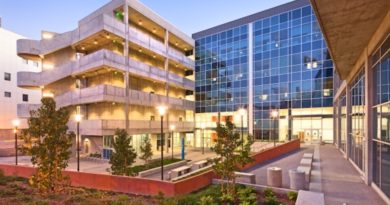Daily Business Report-July 19, 2016
The Fairbanks Ranch Country Club hosted equestrian events at the 1984 Summer Olympics.
Fairbanks Ranch Country Club
Sold to The Bay Club Company
The Bay Club Company, a San Francisco-based active lifestyle corporation, is to announce Wednesday the acquisition of the Fairbanks Ranch Country Club in Rancho Santa Fe, host to equestrian events in the 1984 Summer Olympics, and The Golf Club at Boulder Ridge in San Jose.
Financial details were not released.

Built in 1983, the 274-acre Fairbanks Ranch Country Club includes a 27-hole golf course, eight tennis courts, and a clubhouse. It is The Bay Club Company’s second property in its San Diego campus, along with Bay Club Carmel Valley, located less than five miles south.
“The addition of Fairbanks Ranch Country Club, coupled with the recent significant renovations of Bay Club Carmel Valley, creates an almost unlimited assortment of amenities and signature benefits for our San Diego campus membership,” said Bobbi Quick, The Bay Club Company executive vice president of operations.
“We’re excited to expand our golf footprint and give our members access to two more preeminent California courses,” says The Bay Club Company President and CEO Matthew Stevens. He adds: “Our plan is to evolve the traditional country club membership into a more modern and flexible offering that suits the needs of today’s dynamic families. The Bay Club golf membership model eliminates food and beverage minimums and cart fees, includes complimentary childcare and camp for the families. In addition, we have robust programming ranging from summer concerts, unique fitness classes and exciting sports tournaments.”
The Bay Club Company operates 20-plus locations across multiple California campuses. The campuses are comprised of multiple properties within an area that feature complementary amenities, thereby providing its members a collection of offerings too vast to be accessible at any single location. These properties include fitness centers, athletic clubs, swim and tennis clubs, and country and golf clubs.
________________________________________________

Chargers’ Stadium Plan and Tourism
Tax Officially on November Ballot
By City News Service
The San Diego City Council voted Monday to put two initiatives that have qualified for the ballot before voters in November — the Chargers’ plan to build a downtown stadium and another that would direct the future of tourism funding in San Diego.
Councilman Chris Cate will provide the ballot statement in opposition of the so-called Chargers initiative, while Councilman Scott Sherman will write the ballot statement in opposition of the so-called Citizens Plan, also known as the Briggs-Frye initiative.
The council vote was 8-0, with Councilwoman Marti Emerald absent.
“There are political issues, there are all kinds of emotional issues with regard to the team and I’m not concerned with those today, although those will certainly play out in the campaign,” Councilman Mark Kersey said. “I think the biggest deficiency with this plan as submitted is the lack of attention to the city’s infrastructure surrounding the proposed stadium.”
Typically, when an initiative qualifies for the ballot, the City Council would be tasked with deciding whether to adopt the provision or place the issue before voters.
But in this case, the council was compelled to put the initiatives on the ballot because both the Chargers and Briggs-Frye plans seek to raise San Diego’s hotel room tax. Any tax increases must, by law, be passed by voters and not simply imposed by the council.
The levy on hotel guests is currently 10.5 percent, plus a 2 percent fee for tourism promotion.
The Chargers’ plan would raise the tax to 16.5 percent, effectively a hike of 4 percentage points. The extra revenue, along with contributions by the team and National Football League, would fund construction of a stadium and convention center annex in the East Village, near Petco Park.
The Citizens Plan, backed by former Councilwoman Donna Frye and lawyer Cory Briggs, would increase the levy to 15.5 percent. It would also prohibit a waterfront expansion of the San Diego Convention Center and encourage San Diego State University and UC San Diego to build a research center on the Qualcomm Stadium site.
“The citizen’s plan elements have a common theme and a single purpose, to support the responsible management of the city’s major tourism and entertainment-related facilities and infrastructure,” Frye said during public comment before the council voted.
“A public vote is important,” Fry said.
The Briggs-Frye plan would also require voter approval of any public funds that would be spent on building a downtown stadium for the Chargers, and support the creation of parkland along the San Diego River.
In April, City Attorney Jan Goldsmith issued a scathing opinion of the Citizens Plan, contending that the initiative is flawed and would subject the city to “significant risk.” He did not, however, recommend keeping it off the November ballot or challenging its legality in court.
“Direct democracy is a constitutional right in this state and voters have a right to be heard,” Goldsmith said in his remarks to the council. “They (voters) actually own the legislative process and they delegate it to council members and to legislators.”
Port Tenants Association Awarded $5.9M
Grant by California Energy Commission
The California Energy Commission has awarded the San Diego Port Tenants Association a $5.9 million grant to fund the development of 10 all-electric freight vehicles outfitted with zero-emission technologies for operation at the Port of San Diego.
The grant award will be matched with $2.3 million in cash and in-kind contributions from the seven partner tenants of the tenants association: CEMEX, Continental Maritime, Dole Food Company, Harborside Refrigerated Services and Cold Storage, Marine Group Boatworks, Pasha Group and TerminaLift. Together the total project budget is $8.2 million.
“We are incredibly proud of the California Energy Commission grant because it proves our small but committed association is dedicated to protecting the environment,” said George Palermo, chair of the association. “We partnered with our industrial tenants as well as with San Diego Gas & Electric, the Grant Farm and the Port of San Diego to come out as the top awardee with the Energy Commission. We couldn’t be prouder and we will excel in production of 10 zero-emissions freight vehicles.”
The SDPTA was one of two recipients of the “Freight Transportation Projects at California Seaports” grant program of the California Energy Commission under the Alternative and Renewable Fuel and Vehicle Technology Program for the state. The grant is provided to fund demonstration projects for medium- and heavy-duty vehicle technologies, intelligent transportation systems and technologies, and deployment of natural gas vehicles.
City to Oversee $14 Million Rehab
Of the Georgia Street Bridge
The city will start construction today on a $14 million project to rehabilitate the Georgia Street Bridge in North Park.
Councilmember Todd Gloria will join regional elected officials, engineering staff, contractors, and community leaders in a construction commencement ceremony at 1 p.m. at the bridge at Georgia Street and University Avenue.
Originally built in 1914, the bridge and its retaining walls will undergo seismic retrofitting and rehabilitation. The project will include roadway lowering on University Avenue by about two and a half feet, sidewalk upgrades, and restoration of the bridge’s open balustrades and lighting fixtures to their historic condition.
The project is budgeted at $14 million, with $2 million coming from local TransNet proceeds and the remaining $12 million from Federal Highway Administration grants.
The rehabilitation project is being conducted by the city of San Diego’s Public Works Department and work is expected to be completed in summer of 2017.
Business Outlook Drops to All-Time
Low After Minimum Wage Increase
Times of San Diego
In the wake of the city’s minimum-wage increase, confidence among county businesses has dropped to an all-time low, according to a forecast released Monday by the San Diego Regional Chamber of Commerce.
The monthly Silvergate Ban-sponsored business forecast fell to its lowest point since the survey began in August 2013. The so-called business outlook index has been up and down since January and is now at 15.7, down from 21.3 last month, according to the chamber.
While this is the lowest point the index has hit since the survey’s start, the business community’s outlook is still in positive territory since the results can range from a high of 100 to a low of negative 100.
This month’s forecast also took the annual measurement of how business friendly local governments are and whether firms are considering moving out of the county. The findings showed that not much has changed since last year, according to the chamber.
Most businesses see their local government as being overall friendly to commerce, and the percentage of businesses considering a move out of the county has essentially remained the same at 13 percent.
“We continue to see the impact government regulations, specifically minimum wage increases, have on the local business climate,” said Jerry Sanders, president and CEO of the chamber. “This month, we see minimum wage contributing to how friendly businesses view government and in turn, how likely a company is to relocate.”
“This is important information for our elected officials when considering business retention in the region, Sanders added.
The new city minimum wage of $10.50 per hour went into effect on July 11.
City News Service contributed to this article.
National University Names
Permanent Provost
By City News Service
San Diego-based National University announced Friday that Gangaram Singh was named provost on a permanent basis, after serving in an interim role over the past year. As provost, Singh is the university’s top academic officer.
“Dr. Singh has been a dedicated member of the National University leadership team, and he is held in high regard by faculty, staff and administrators,” said David Andrews, president of National University. “We are pleased to have him continue with us as provost as he is committed to ensuring the highest standards for our students’ academic experiences.”
Singh joined National University two years ago as associate provost after holding academic leadership positions at San Diego State University.
He earned a doctorate in Industrial Relations at the University of Toronto and has been published in more than 70 academic and practitioner journals, according to National University.
Chamber Study Finds Housing
A Crisis Point in San Diego
Times of San Diego
A new study sponsored by the San Diego Regional Chamber of Commerce finds that housing has reached a crisis point in San Diego County.
The crisis caused by lack of supply is making housing unaffordable, forcing longer commutes, creating greater congestion, and increasing employee and employer dissatisfaction.
Since 1996 the county has added an average of 16,405 jobs per year, but home construction hasn’t kept pace, and has fallen since the Great Recession, according to the study by The London Group.
From 1996 to 2007, building permits averaged 12,753 units per year, but since the economic downturn in 2008, the number has fallen to an average of only 5,968 units per year. Those numbers are far below what’s necessary to support new jobs.
“The on-the-ground reality is that substantially fewer units than anticipated by planning documents will ever be built due to neighborhood resistance, and the financial economics involved in these projects, which mostly will require far more density than is likely to be permitted,” the study’s author Gary London wrote.
The chamber said this mismatch between job growth and housing availability will ultimately stifle economic growth.
“Employers are losing talent every day to places like Austin, Denver and Portland where their employees can spend substantially less of their pay check on a home big enough to comfortably fit their family,” said Sean Karafin, executive director of policy and economic research at the chamber. “We can’t overstate how much our housing affordability crisis is holding back our economy.”
The study predicts that demand for single-family homes will be substantially higher than planners expect, creating another mismatch as Millennials begin to form families and seek to move out of apartments.
Rim of the Pacific 2016

PACIFIC OCEAN (July 17, 2016) Lt. Dion Adams, littoral combat ship USS Coronado’s chief engineer, explains his watch as the tactical action officer to Under Secretary of the Navy Janine A. Davidson during Rim of the Pacific 2016. Davidson is in Hawaii visiting RIMPAC participating units and seeing Great Green Fleet initiatives that are a part of the exercise. Twenty-six nations, more than 40 ships and submarines, more than 200 aircraft and 25,000 personnel are participating in RIMPAC from June 30 to Aug. 4, in and around the Hawaiian Islands and Southern California.
The world’s largest international maritime exercise, RIMPAC provides a unique training opportunity that helps participants foster and sustain the cooperative relationships that are critical to ensuring the safety of sea lanes and security on the world’s oceans. RIMPAC 2016 is the 25th exercise in the series that began in 1971. (U.S. Navy photo by Mass Communication Specialist 1st Class Benjamin A. Lewis)



